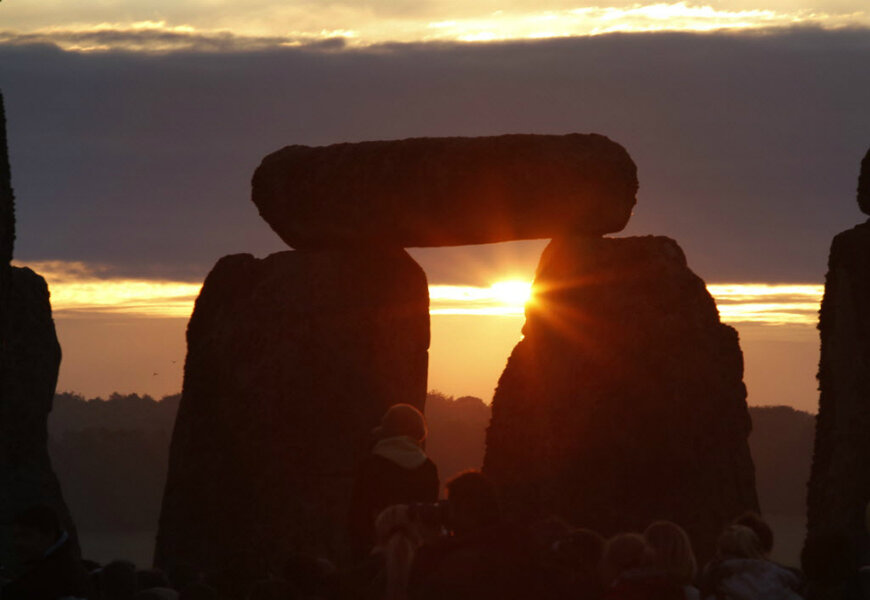Winter solstice 2015: What's a solstice anyway?
Loading...
The winter solstice is the shortest day and longest night of the year, at least in the Northern Hemisphere.
Technically, the solstice happens today at the same time for everyone on Earth.
The winter solstice is the exact time the Northern Hemisphere tilts the farthest distance away from the sun. In New York, the solstice happens at 11:48 p.m. Eastern Time on Monday, Dec. 21. The sun remains visible for just nine hours and 26 minutes in Washington, D.C., during the winter solstice, though days are shorter farther up north, The Washington Post reports.
Given the time zone differences, the solstice doesn't happen until Tuesday in Africa, Asia, and Europe, USA Today reports.
For people living in the Southern Hemisphere, Dec. 21 marks the summer solstice, the beginning of the astronomical summer and the longest day of their year, according to NASA.
In the Northern Hemisphere many people view Dec. 21 as the official beginning of winter, a day celebrated for millennia and shown through ancient monuments such as Stonehenge in England.
Ancient people dating back thousands of years saw the solstices as significant. The Mayan people constructed a building along the Caribbean coast in the city of Tulum, now in modern-day Mexico, that captures the sun’s rays during sunrise on the summer and winter solstice, illuminating a room through a small hole.
The Goseck circle in Germany dating back nearly 7,000 years is a sequence of giant circles that researchers believe were once used for religious ceremonies. Two gates discovered at the site were found to align with the sunrise and sunsets on the winter solstice.
The winter solstice takes place when the position of the Earth’s axis causes land in the north to slant away from the sun thus limiting the amount of rays that reach the region. According to NASA the solstice is related to man-made “imaginary lines” used to navigate and track time.
The equator divides the earth down the middle while the North and South poles quantify the Earth’s axis of rotation and its tilt, which is the reason various parts of the world have different seasons. Scientists posit that the Earth is angled that way because of ancient collisions billions of years ago, leading it to its current tilt of 23.5 degrees, according to the joint NASA-NOAA educational website:
You may have noticed two special lines of latitude on a globe of the world: One in the Northern Hemisphere called the Tropic of Cancer at +23.5° latitude and one in the Southern Hemisphere called the Tropic of Capricorn at − 23.5° latitude.
These are the latitudes where the Sun is directly overhead at noon once a year. In the Northern hemisphere, on the Tropic of Cancer, that is the Summer Solstice, usually June 21. In the Southern Hemisphere, on the Tropic of Capricorn, that is the Winter Solstice, usually December 21. These solstice days are the days with the most (for Summer) or fewest (for Winter) hours of sunlight during the whole year.
It may be the longest night, but the winter solstice is not the coldest time of the year, with January holding that title based on statistical analysis and weather trends.
The reason is called seasonal lag, according to the National Oceanic and Atmospheric Administration’s (NOAA) National Climatic Data Center, which occurs mostly because of the Earth’s land and oceans release the sunlight it absorbs over time. Soil above 30 feet holds in heat, even when air temperatures plummet, NOAA said.
Anthony Arguez, a physical scientist with NOAA, told Katharine Gammon of Inside Science News Service last year that the same thing happens during the summer solstice on June 21, considered the official start of summer. In fact, the hottest day of the year in the Northern Hemisphere is typically in July or August.
“There’s not a good answer for why people say that December 21 is the beginning of winter,” he said. “There’s nothing magical that says that winter has to happen after the solstice.”







